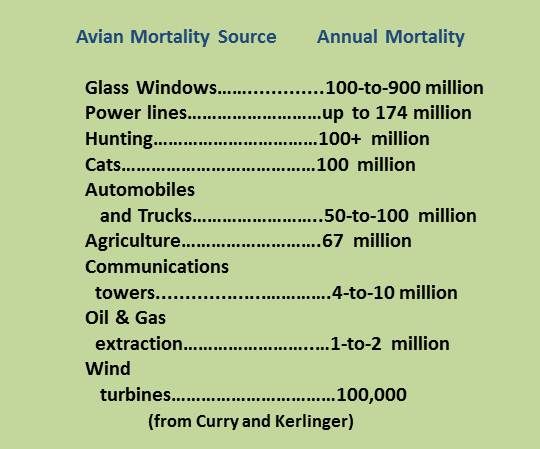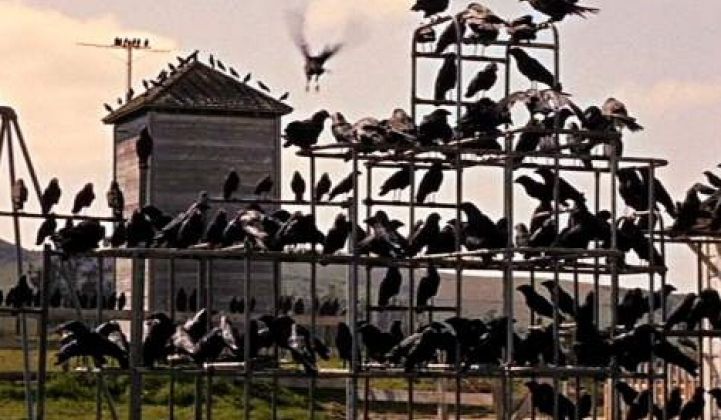Last month, biologists found 484 bird carcasses at the AES-owned Laurel Mountain wind installation in West Virginia.
The mass mortality event did not involve turbines.
Despite the carnage that lies ahead for turkeys this holiday season in the U.S., most people are pro-bird. There are very few anti-bird initiatives. And nobody wants to connect the naturalists’ phrase 'mass mortality event' with them.
But mass mortality events happen. They happen to whales. And seals. And the bees and the birds.
Also known as die-offs, small events are common with birds and large events are not unusual, especially for birds that flock and migrate. The primary causes are things like disease, storms or predators. Pollution and collisions with vehicles, buildings and power lines also kill birds in large numbers. And it seems mass mortality events are becoming more common as the distance between birds and humans narrows.
In the case of the AES wind installation, the likely cause was that migrating birds were drawn to lights left on at the facility’s electrical substation in cold foggy weather. The birds, it is theorized, were galvanized and disoriented by the bright lights and circled until they died and fell out of the sky.
“The first thing to understand is that this had nothing to do with wind turbines,” said John Anderson, American Wind Energy Association (AWEA) Director of Siting Policy. “It was a lighting issue,” Anderson explained, “and [was also attributable to] low visibility conditions.”
At a high school in Elkins, West Virginia, the closest town to the Laurel Mountain wind project, “A similar event occurred about three years ago, and in that instance, more than 500 birds were killed in one evening,” Anderson added. “Mass mortality events happen pretty regularly.”
"The mass mortality event in West Virginia was not the first to happen there,” agreed renowned biologist and bird fatality expert Paul Kerlinger. Nor was it the first to happen at a wind project site there.
Steadily burning lights attract migrating birds, especially in foggy and drizzly weather, Dr. Kerlinger said, citing detailed findings he has reported throughout a distinguished academic and research career in many published papers on avian fatalities from collisions with tall towers and wind turbines.

“I’ve warned people many times about this,” Kerlinger said. He noted “an event at a pumping station in Kansas where 5,000 birds died in a single night.” Mass mortality events have happened “over and over again at different types of facilities,” he said. “A Holiday Inn on the Blue Ridge Parkway in Virginia had a large-scale event involving hundreds of dead birds in a single night.”
Anderson noted, “The National Academy of Sciences reported in 2007 that three out of every 100,000 human-related sources of bird fatalities could be attributed to wind.”
Kerlinger said he had been a peer-reviewer for the paper Anderson referenced and endorsed its accuracy.
According to Kerlinger’s January 2011 paper, “Approximately 100,000 birds are killed by wind turbines each year in the U.S., based on an average of about 3+ birds per turbine per year times 30,000 turbines.” He added that this “does not appear to be causing significant impacts to populations.”
In the same paper, Kerlinger reported that 4 million to 50 million birds are estimated to be killed yearly by communication towers, which is 40 to 500 times more than those killed wind turbines. Both numbers are expected to increase as more turbines and communications towers are built. But, Kerlinger added, “There is an easy solution.”
In Michigan, where his recommendations were heeded, steadily burning lights on communications towers were replaced by flashing lights “and the fatality rates went down by 50 percent to 70 percent.”
Laurel Mountain is a 98-megawatt wind installation near Elkins, West Virginia, with 61 1.6-megawatt GE turbines. More relevantly, it is the site of a 32-megawatt battery storage installation designed to provide transmission system operator PJM with instantaneous load regulating capacity vital to the grid integration of renewables.
The batteries were supplied by A123 Systems and operated by AES Energy Storage. It was the transmission substation and battery storage illumination that was left on and tragically attracted the migrating birds.
“My expectation is that AES, the owner-operator, is going to make sure the lights are kept off,” Anderson said of future Laurel Mountain wind project operations, “except for emergency situations.”
“The industry still needs to embrace simple, bird-smart principles that would dramatically reduce incidents,” Kelly Fuller, the American Bird Conservancy Wind Campaign Coordinator, said in a press statement.
Anderson called leaving the lights on “operator error” and said “it can be avoided in the future” because, thanks in large part to the work of Kerlinger and his colleagues, the industry and the relevant regulatory agencies are aware of the kind of lighting required.
“The basic message is that the wind power industry deeply regrets this,” Anderson said, “but the important thing to note is that this is an anomaly. We pride ourselves in studying, monitoring and mitigating for impacts,” he added. “Most of what we do is above and beyond what is legally required [and] we expect that in time we will improve and do more.”
A wildlife expert at AES said the company has turned off the lights at the electrical substation. The lights were on, the source who asked not to be identified said, both to prevent vandalism and because since September 11, 2001, transmission interconnections have been regarded as potential terrorist targets.
The lights will remain off, the source said, until they can be replaced with fixtures that do not attract migrating birds. Alternative security measures have been put in place.



